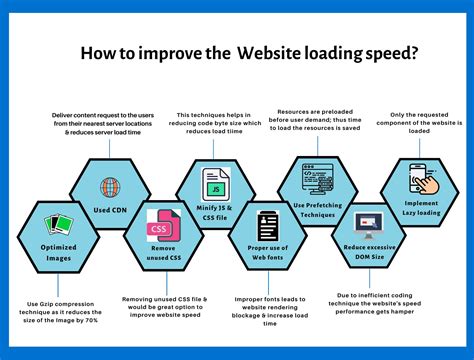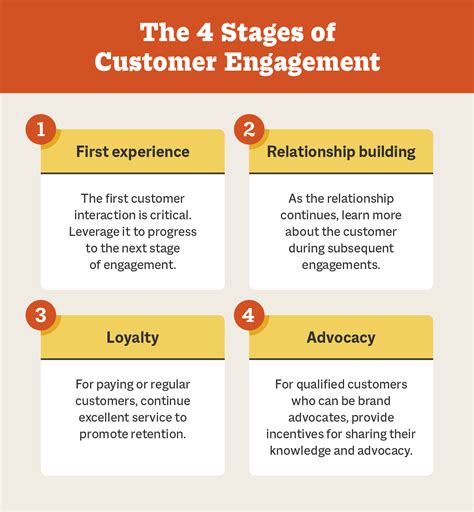Creating a successful website is not just about incorporating eye-catching visuals or catchy taglines. It is an art of crafting an online platform that captivates the audience, delivers the desired message effectively, and encourages interaction. To achieve these goals, it is crucial to optimize your website performance and increase user engagement. Here are some valuable insights to help you achieve these objectives.
1. Enhance Website Loading Speed
In today's fast-paced digital world, users expect instant access to information. A slow-loading website can immediately discourage visitors and drive them away. Optimizing your website's loading speed is of utmost importance. Reduce image sizes, minify CSS and JavaScript files, and leverage caching techniques to make your website lightning fast. The faster your website loads, the more likely users will engage with your content.
2. Create Seamless Navigation
Navigation is the backbone of any website. It is the pathway that guides users through your content and enables them to explore your website effortlessly. Design a clear and logical navigation system that allows visitors to find what they are looking for quickly. Include intuitive menus, search bars, and breadcrumbs to enhance user experience. Additionally, consistency in navigation elements across different pages enhances user-friendliness and simplifies the overall browsing process.
3. Focus on Responsive Design
A responsive website design ensures that your website adapts seamlessly to different screen sizes and devices, providing optimal user experience on desktops, smartphones, and tablets. As mobile usage continues to soar, having a mobile-friendly website has become more important than ever. Invest in a responsive design that automatically adjusts content layout and ensures easy readability and navigation, regardless of the device being used.
4. Implement Engaging Content
Content is king when it comes to engaging and retaining website visitors. Craft compelling and informative content that resonates with your target audience. Use catchy headlines, concise paragraphs, and bullet points to make your content visually appealing and easy to read. Incorporate multimedia elements such as videos, infographics, and relevant images to increase user engagement. Additionally, don't forget to optimize your content for search engines to attract organic traffic and improve your website's visibility.
5. Encourage User Interaction
Engage your users by incorporating interactive elements on your website. Encourage comments, facilitate discussions, and provide ways for users to share their opinions and experiences. Implement features like social media sharing buttons, user ratings, and reviews to foster a sense of community and encourage user participation. The more users feel involved and valued, the longer they will stay on your website and interact with your content.
By implementing these tips, you can optimize your website's performance and create an engaging user experience. Remember, a well-performing website not only attracts more visitors but also keeps them coming back for more, thereby increasing your chances of achieving your goals.
Optimizing Your Website's Performance: Key Strategies to Boost Speed and Efficiency

Introduction:
Enhancing the overall performance of your website is crucial to providing a seamless user experience and ensuring visitors stay engaged. This section will delve into key strategies you can employ to optimize your website's speed and efficiency, resulting in improved user satisfaction and increased conversion rates.
| Section | Strategy |
|---|---|
| 1 | Streamlining Code and Minifying Files |
| 2 | Utilizing Caching Mechanisms |
| 3 | Optimizing Images for Web |
| 4 | Implementing Content Delivery Networks (CDNs) |
| 5 | Reducing HTTP Requests |
| 6 | Compressing Files for Faster Loading |
| 7 | Optimizing Database Queries |
| 8 | Enabling Gzip Compression |
| 9 | Using a Content Delivery Network (CDN) |
By implementing these strategies, you can significantly enhance your website's performance, resulting in faster loading times, improved responsiveness, and a seamless user experience for your valuable visitors.
Optimize Images to Enhance Website Loading Speed
When it comes to enhancing the performance of your website and providing a better user experience, optimizing images plays a crucial role. Images are an essential element of web design, bringing visual appeal and engaging users. However, large image file sizes can significantly impact the loading time of your website, leading to a higher bounce rate and lower user engagement.
By optimizing images for faster loading times, you can ensure that your website loads quickly and efficiently, allowing users to access your content without any delays. Optimization techniques such as compressing images, reducing file sizes, and using modern image formats enable you to maintain high-quality visuals while improving overall performance.
- Compress Images: Utilize image compression tools or plugins to reduce the file size of your images without compromising quality. This reduces the time it takes to load images on your website.
- Choose the Right Format: Select an appropriate image format based on the content and purpose of the image. For example, JPEG is suitable for photographs, while PNG is ideal for graphics with transparency.
- Resize Images: Resize images to fit the dimensions required by your website design. Avoid using large images and then resizing them using HTML or CSS, as this can slow down loading times.
- Lazy Loading: Implement lazy loading techniques to prioritize the loading of images that are currently visible to the user, while delaying the loading of off-screen images. This helps improve initial loading times.
- Optimize Image Alt Text: Ensure that your image alt text is descriptive and relevant, improving accessibility for visually impaired users and aiding in search engine optimization.
By implementing these image optimization techniques, you can significantly enhance the loading speed of your website, ultimately increasing user engagement and satisfaction. Remember, small actions such as optimizing images can have a significant impact on the overall performance of your website, so take the time to apply these methods to improve the user experience.
Optimize Server Load with Effective Caching Techniques

In today's digital landscape, it is imperative for websites to ensure seamless performance and enhance user experience. One effective strategy for achieving this goal is utilizing caching techniques to reduce server load. By implementing caching methods, websites can intelligently store and deliver frequently accessed data, enhancing overall performance and reducing the burden on the server.
Caching involves the temporary storage of data, files, or web page elements, allowing them to be retrieved quickly and efficiently when needed. This technique minimizes the need for repetitive requests to the server, resulting in faster load times and improved user engagement. Efficient caching not only benefits the end-user, but also significantly reduces bandwidth consumption and server processing power.
There are various caching techniques that website owners can implement to optimize server load. One widely used method is browser caching, which instructs a user's web browser to store certain static files, such as images, CSS, and JavaScript, locally. By doing so, subsequent visits to the website can be served from the browser's cache, reducing the amount of data that needs to be fetched from the server.
Another approach is server-side caching, where a website's server generates and stores pre-rendered HTML pages or fragments. These cached versions can then be served to users instead of dynamically generating the content for each request. This technique is particularly useful for pages that are relatively static and don't require frequent updates.
Content delivery network (CDN) caching is another effective method for reducing server load. A CDN caches website content on multiple servers located in different geographic regions. When a user requests a specific page, the CDN delivers the cached content from the server that is closest to the user's location. This reduces latency and minimizes the load on the origin server.
By incorporating these caching techniques into your website's performance optimization strategy, you can greatly enhance user experience, reduce server load, and ultimately optimize the overall performance of your website. Implementing caching methods is a proactive step towards delivering a fast, efficient, and engaging user experience.
Optimize Your Web Pages: Reduce File Sizes and Improve Loading Speeds
Boost the performance and user experience of your website by optimizing your web pages. One effective technique is to minimize and combine CSS and JavaScript files, resulting in reduced file sizes and faster loading times. By implementing this strategy, you can enhance the efficiency and speed of your website without compromising its design or functionality.
To begin the optimization process, examine your existing CSS and JavaScript files. Identify any duplicate or unnecessary code that can be removed. Minification entails removing white spaces, line breaks, and other unnecessary characters from the code, resulting in smaller files. By removing these extraneous elements, you can significantly reduce the file size and improve loading times.
Furthermore, instead of multiple separate CSS and JavaScript files, consider combining them into a single file. This consolidation reduces the number of HTTP requests required, further enhancing the loading speed. However, ensure that the combined file retains logical organization and readability. Utilize comments to separate different sections or components, making it easier to navigate and maintain the codebase.
When you apply minification and file combination techniques, it is crucial to thoroughly test your website to ensure proper functionality. Use online tools or plugins that can automate the minification and combination process, and check for any unwanted side effects. Additionally, monitor your website's performance to assess the impact of these optimizations.
In conclusion, optimizing your webpage by minifying and combining CSS and JavaScript files is an effective way to improve website performance and enhance user engagement. By reducing file sizes and improving loading speeds, you can create a seamless browsing experience for your visitors, resulting in increased satisfaction and improved overall user engagement.
Strategies to Boost User Interaction

Enhancing user engagement on your website is crucial for maintaining a loyal and active audience. By implementing effective strategies, you can create an immersive online experience that fosters continuous user interaction and drives valuable actions. In this section, we will explore various approaches to maximize user engagement without compromising website performance or overall user satisfaction.
- Promote personalized content: Tailoring your website content to each user's preferences and interests can significantly increase engagement. By leveraging user data, such as browsing history and demographic information, you can deliver relevant and targeted content that resonates with your audience.
- Implement gamification elements: Incorporating gamification elements into your website can inject excitement and create a sense of challenge for users. By incorporating leaderboards, badges, and rewards, you can motivate users to actively participate and compete for achievements.
- Encourage social sharing: Integrating social media sharing buttons allows users to easily share your content with their network, spreading awareness and driving new traffic. By optimizing the sharing experience and incentivizing users to share, you can amplify your reach and generate organic growth.
- Create interactive features: Adding interactive features, such as quizzes, polls, and surveys, can captivate users and encourage them to actively engage with your website. Interactive elements provide an opportunity for users to voice their opinions, contribute to the conversation, and feel involved in your brand's community.
- Facilitate seamless navigation: A user-friendly and intuitive website navigation is crucial for enhancing user engagement. Streamlining the navigation structure, optimizing search functionality, and providing clear calls-to-action can empower users to explore your website with ease and find relevant information effortlessly.
- Encourage user-generated content: Allowing users to generate and share their content on your website can foster a sense of ownership and community. By implementing features such as user reviews, comments sections, and user-submitted content, you can empower users to contribute and engage actively with your brand.
By implementing these user engagement strategies, you can create a dynamic and captivating online environment that not only keeps users coming back but also encourages them to actively participate and advocate for your brand.
FAQ
What are some tips for improving website performance?
There are several tips for improving website performance. First, optimize your images and use compressed file formats to reduce their size. Second, minify your CSS and JavaScript files to reduce their file sizes. Third, enable browser caching to allow the browser to store website files locally, making subsequent visits faster. Fourth, use a content delivery network (CDN) to deliver your website's files from servers closer to the user. Finally, regularly monitor and optimize your website code and database to ensure efficient performance.
How can I increase user engagement on my website?
Increasing user engagement on your website can be done through various strategies. First, make sure your website has a well-designed and intuitive user interface, allowing users to easily navigate and find what they're looking for. Second, provide valuable and engaging content that is relevant to your target audience. This could include blog posts, videos, or interactive elements. Third, encourage user interaction through comments, social sharing buttons, and user-generated content. Fourth, optimize your website for mobile devices to make it accessible and user-friendly on smartphones and tablets. Finally, regularly analyze user data and feedback to understand their preferences and tailor your website accordingly.
What are the benefits of optimizing images on a website?
Optimizing images on a website has several benefits. Firstly, it reduces the file size of images, resulting in faster loading times and improved website performance. This is crucial, as slow loading times can lead to high bounce rates and a negative user experience. Secondly, optimized images consume less bandwidth, making it more cost-effective for users with limited data plans. Thirdly, properly optimized images can improve your website's search engine optimization (SEO) by reducing the overall page size. Finally, optimized images can ensure that your website is accessible to users on slower internet connections or older devices.
Why is minifying CSS and JavaScript important for website performance?
Minifying CSS and JavaScript files is important for website performance because it significantly reduces their file sizes. When these files are minified, unnecessary characters like white spaces, comments, and line breaks are removed, resulting in a streamlined and more efficient code. This reduces the download time required for these files, making the website load faster. Faster loading times improve the overall user experience, as users no longer have to wait long for the website to fully load. It also reduces the amount of data that needs to be transferred, benefiting users with limited bandwidth or slower internet connections.
What is the role of a content delivery network (CDN) in website performance?
A content delivery network (CDN) plays a crucial role in website performance. It is a network of distributed servers located in various geographical locations. When a user visits a website, the CDN delivers the website's files from the server closest to the user, reducing the distance the data needs to travel. This results in faster loading times and improved website performance. In addition, CDNs also help distribute the load on the website's infrastructure, preventing it from being overwhelmed by traffic spikes and ensuring a consistent user experience. Overall, using a CDN can greatly enhance the speed, reliability, and scalability of a website.
What are some tips for improving website performance?
There are several tips for improving website performance. Firstly, optimizing images and videos can significantly reduce loading times. Secondly, minifying CSS and JavaScript files can help streamline code and improve page speed. Thirdly, implementing caching mechanisms such as browser caching and server-side caching can greatly enhance website performance. Finally, using a content delivery network (CDN) can distribute website content across multiple servers and improve loading times for users around the world.



